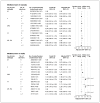Sex ratios at birth after induced abortion
- PMID: 27067818
- PMCID: PMC4902709
- DOI: 10.1503/cmaj.151074
Sex ratios at birth after induced abortion
Abstract
Background: Skewed male:female ratios at birth have been observed among certain immigrant groups. Data on abortion practices that might help to explain these findings are lacking.
Methods: We examined 1 220 933 births to women with up to 3 consecutive singleton live births between 1993 and 2012 in Ontario. Records of live births, and induced and spontaneous abortions were linked to Canadian immigration records. We determined associations of male:female infant ratios with maternal birthplace, sex of the previous living sibling(s) and prior spontaneous or induced abortions.
Results: Male:female infant ratios did not appreciably depart from the normal range among Canadian-born women and most women born outside of Canada, irrespective of the sex of previous children or the characteristics of prior abortions. However, among infants of women who immigrated from India and had previously given birth to 2 girls, the overall male:female ratio was 1.96 (95% confidence interval [CI] 1.75-2.21) for the third live birth. The male:female infant ratio after 2 girls was 1.77 (95% CI 1.26-2.47) times higher if the current birth was preceded by 1 induced abortion, 2.38 (95% CI 1.44-3.94) times higher if preceded by 2 or more induced abortions and 3.88 (95% CI 2.02-7.50) times higher if the induced abortion was performed at 15 weeks or more gestation relative to no preceding abortion. Spontaneous abortions were not associated with male-biased sex ratios in subsequent births.
Interpretation: High male:female ratios observed among infants born to women who immigrated from India are associated with induced abortions, especially in the second trimester of pregnancy.
© 2016 Canadian Medical Association or its licensors.
Figures



Comment in
-
Male-biased infant sex ratios and patterns of induced abortion.CMAJ. 2016 Jun 14;188(9):640-641. doi: 10.1503/cmaj.160183. Epub 2016 Apr 11. CMAJ. 2016. PMID: 27067822 Free PMC article. No abstract available.
-
Are we consistent?CMAJ. 2016 Aug 9;188(11):823. doi: 10.1503/cmaj.1150112. CMAJ. 2016. PMID: 27503993 Free PMC article. No abstract available.
Similar articles
-
Sex ratios among Canadian liveborn infants of mothers from different countries.CMAJ. 2012 Jun 12;184(9):E492-6. doi: 10.1503/cmaj.120165. Epub 2012 Apr 16. CMAJ. 2012. PMID: 22508977 Free PMC article.
-
Induced abortion and low birthweight in the following pregnancy.Int J Epidemiol. 2000 Feb;29(1):100-6. doi: 10.1093/ije/29.1.100. Int J Epidemiol. 2000. PMID: 10750610
-
Reproductive pattern, perinatal mortality, and sex preference in rural Tamil Nadu, south India: community based, cross sectional study.BMJ. 1997 May 24;314(7093):1521-4. doi: 10.1136/bmj.314.7093.1521. BMJ. 1997. PMID: 9169399 Free PMC article.
-
The effects of induced abortion on subsequent reproduction.Epidemiol Rev. 1982;4:66-94. doi: 10.1093/oxfordjournals.epirev.a036252. Epidemiol Rev. 1982. PMID: 6754410 Review.
-
The effect of pregnancy termination on future reproduction.Baillieres Clin Obstet Gynaecol. 1990 Jun;4(2):391-405. doi: 10.1016/s0950-3552(05)80234-2. Baillieres Clin Obstet Gynaecol. 1990. PMID: 2225607 Review.
Cited by
-
Male-biased sex ratios in Australian migrant populations: a population-based study of 1 191 250 births 1999-2015.Int J Epidemiol. 2018 Dec 1;47(6):2025-2037. doi: 10.1093/ije/dyy148. Int J Epidemiol. 2018. PMID: 30052991 Free PMC article.
-
Infant mortality among the Canadian-born offspring of immigrants and non-immigrants in Canada: a population-based study.Popul Health Metr. 2016 Aug 30;14(1):32. doi: 10.1186/s12963-016-0101-5. eCollection 2016. Popul Health Metr. 2016. PMID: 27582637 Free PMC article.
-
Determinants of imbalanced sex ratio at birth in Nepal: evidence from secondary analysis of a large hospital-based study and nationally-representative survey data.BMJ Open. 2019 Jan 30;9(1):e023021. doi: 10.1136/bmjopen-2018-023021. BMJ Open. 2019. PMID: 30705238 Free PMC article. Clinical Trial.
-
Procedural abortion, provider-initiated preterm delivery and survival in pregnant people with cancer: A population-based cohort study.BJOG. 2025 Jan;132(1):81-88. doi: 10.1111/1471-0528.17937. Epub 2024 Aug 21. BJOG. 2025. PMID: 39169531 Free PMC article.
-
Variations in male-female infant ratios among births to Canadian- and Indian-born mothers, 1990-2011: a population-based register study.CMAJ Open. 2016 Mar 31;4(2):E116-23. doi: 10.9778/cmajo.20150141. eCollection 2016 Apr-Jun. CMAJ Open. 2016. PMID: 27398354 Free PMC article.
References
-
- Jacobsen R, Moller H, Mouritsen A. Natural variation in the human sex ratio. Hum Reprod 1999;14:3120–5. - PubMed
-
- Rodgers JL, Doughty D. Does having boys or girls run in the family? Chance 2001;14:8–13.
-
- Chahnazarian A. Determinants of the sex ratio at birth: review of recent literature. Soc Biol 1988;35:214–35. - PubMed
-
- James WH. Hypotheses on the stability and variation of human sex ratios at birth. J Theor Biol 2012;310:183–6. - PubMed
MeSH terms
Grants and funding
LinkOut - more resources
Full Text Sources
Other Literature Sources
Medical
